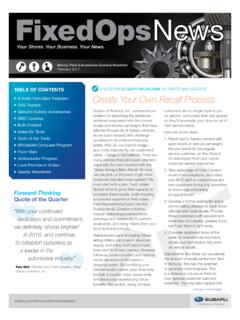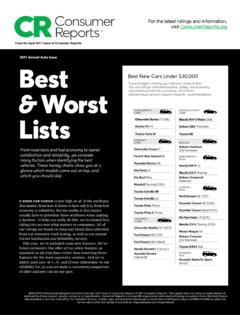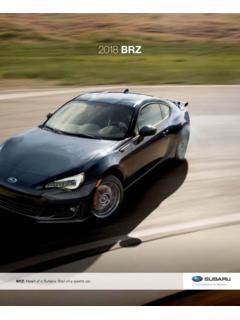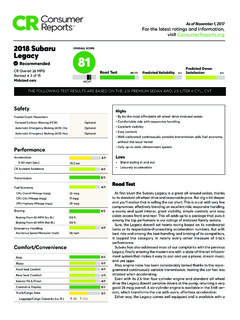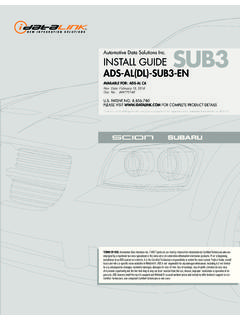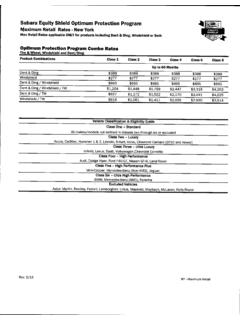Transcription of Subaru: The Emotional Myths Behind the Brand's Growth
1 subaru : The Emotional MythsBehind the Brand's GrowthSAL marketers understand that they are not in the business of selling products orservices. They are in the business of building and maintaining strong, enduring brandsthat sell and sell and sell. The key to building and maintaining strong, enduring brandsis advertising with a compelling story and a strategic focus ("strategic storiedadvertising"). Advertising with a compelling story and a strategic focus works tocreate meaning for the brand and give it an appealing identity and personality that inturn work to create an Emotional connection with the consumer.
2 We are storiedcreatures. Our life is a story. We communicate through telling and listening to , enduring brands use the power of story and/or mythic images to create (orrepresent) mytho-symbolic brand building worlds. These mytho-symbolic worlds areoften drawn from archetypal (universal) stories, characters, beliefs, etc. that existwithin our culture .. and our collective psyche. Storied brands come to representappealing mytho-symbolic worlds, with their own mythology, symbolism, and values,that work to maintain and reinforce the Brand's identity, personality, and emotionalconnection with the SO LONG AGO.
3 subaru was an also-ranthird-tier Japanese car company, struggling in theshadows of Toyota and Honda. Not any has become a popular brand. Buyers havebeen lining up to buy the various models. Evenwith a slumping economy, subaru sales have beenon the turning point came in 1993. subaru waslimping along, with seven years of declining sales,when George Muller, a subaru executive, madetwo important decisions. He decided to focussolely on importing all-wheel-drive vehicles toAmerica. And he hired a new advertising agency,Temerlin McClain of Dallas, which was chargedwith creating an advertising campaign that wouldlaunch the all-wheel-drive Outback in decided to use Paul Hogan as the spokes-person for the new subaru after the Paul Hogan advertising beganrunning, subaru showrooms began seeing an in-crease in buyer traffic.
4 And sales began to in-crease. In fact, subaru enjoyed seven straight yearsof increasing sales during the time Temerlin Mc-Clain was running its Paul Hogan campaign. Thestunning comeback astonished the hard-nosed au-tomotive industry that had already given the carcompany up for dead. What happened? What didSubaru do right?Undoubtedly, there was a confluence of factors:Muller's foresight and courage; the fact that theall-wheel-drive Outback offered consumers thesafety and performance of an SUV but on asmaller, more fuel-efficient scale that seemed tomake more sense; and of course, Temerlin Mc-Clain's fateful decision to use Paul Hogan as thespokesman for the subaru Outback.
5 Few wouldDOI: 2006 JDOR flflL OF BDOERTISIOG HESEBRCH llSUBARU: Brand's Growth Myths argue that using Paul Hogan as spokes-man for subaru was an important factorin subaru 's amazing success story. Thequestion is why?In an interview, Dennis McClain said,"Paul Hogan was part of the conceptual-ization of the Outback proposition." And"right from the beginning," he saw "anatural tie-in between the Outback nameand Paul Hogan," the Australian actorwho became famous for his portrayal ofthe outback character, Mick Dundee, other words, McClain's decision touse Crocodile Dundee was not only acreative decision but also a strategic deci-sion, because consumers associate PaulHogan with the appealing CrocodileDundee Outback character they remem-ber from the to the Crocodile Dundee Outbackadvertising.
6 subaru did not have a com-pelling story. And it had not yet estab-lished a strong brand identity andpersonality. subaru was selling an all-wheel-drive product instead of a brand. Butconsumers buy brands. A brand is morethan a product. A brand is ultimately aperceptual entity, a host of associations,feelings, imagery, symbolism, etc. that ex-ists in the mind and hearts of Hogan's Crocodile Dundee char-acter and the Outback name gave Subarua compelling story and its own unique brandidentity and personality, which made sensefor the brand and connected emotionallywith the American A STORY?
7 We are receptive to stories because tellingstories and listening to stories seem to bepart of the human condition. Telling sto-ries is a natural and compelling way tocommunicate with consumers. We are sto-ried creatures. Storytelling is as old ashumankind. We tell and listen to storiesall the life is a story, an uncertain, contin-ually reworked narrative, part truth, partfiction, that is unfolding even as we liveit. The stories we tell reveal a lot aboutwho we are, who we would like to be,and what is important to us.
8 We tell sto-ries not only so others can come to un-derstand who we are, but also so that wecan come to understand who we are. Weliterally create our sense of self, our identity,through telling and listening to our ownhalf true and Jung both believed that themost important question we could ask is,"what is the myth [story] by which welive our lives?" We are all searching formeaning in our lives. And we look tostories to help us understand the worldand find meaning.
9 We are continually com-paring our stories with other people's sto-ries in order to try to get ideas and insightsabout how we should live our lives. Sto-ries from books, movies, culture, religion,etc. (and yes, advertising) also serve thesame PERSUASIVE POWER OF A STORYThe goal of advertising (whether throughbuilding brands or otherwise) is ulti-mately to persuade consumers to buy aproduct or service. William Wells saysthere are basically two ways to persuadepeople: "Lecture or Drama/Story" (Wells,1988).
10 The lecture approach uses logic,reason, and rhetoric to persuade us to usea product: "Buy this product because ithas all-wheel-drive." The story or dramaapproach is a more intuitive approachthat relies more on feelings and describes the story approach as"transformational" it takes you inside thestory and delivers a message while creat-ing an Emotional connection with the his book How to Argue & Win EveryTime, Gerry Spence, the highly successfulcriminal trial lawyer, says storytelling isthe secret to his phenomenal success.
